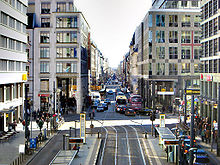Inner city street
An urban street or city street is a street within a closed settlement area . In contrast to roads out of town , their character is determined by the accompanying buildings . Typical is the multi-layered use of the street space by foot , bike , car and local public transport such as the tram .
National
Germany
In Germany the inner-city or city street is a street within a built -up area . The municipality is usually responsible for building such a road , unless it is a private road . In Ortsdurchfahrten of classified roads of road construction, so federal, state or county is responsible for road competence, the sidewalks are always the responsibility of the municipality. Motorways and motorways within built-up areas are still classified as roads outside of town. It is possible, however, that the municipality is their building contractor.
- Marking according to StVO
The street name Stadtstraße also occurs in cities in southern Germany, such as Burgau, Freiburg, Ravenstein and Reutlingen.
Austria
In Austria there is no explicit definition of the term in terms of traffic law; it is generally understood to be a street within the local area (the place-name signs ) in contrast to the Freilandstraße . An attempt is made to carry the signposting with the town extensions, many access roads are initially outside the town area. The roads are all municipal roads, but in large cities there are a number of thoroughfares and access roads ( state roads B - "former federal roads " - and L ). City motorways ( federal highways A and S - expressways ) are not included and are also excluded from the local area.
However, there are building regulations, their system must meet the RVS guideline 03.04.12 cross-sectional design of inner-city streets .
literature
- Wolfgang Pietzsch, Günter Wolf: Street planning . Werner Verlag, Munich 2005, ISBN 3-8041-5003-9 .



